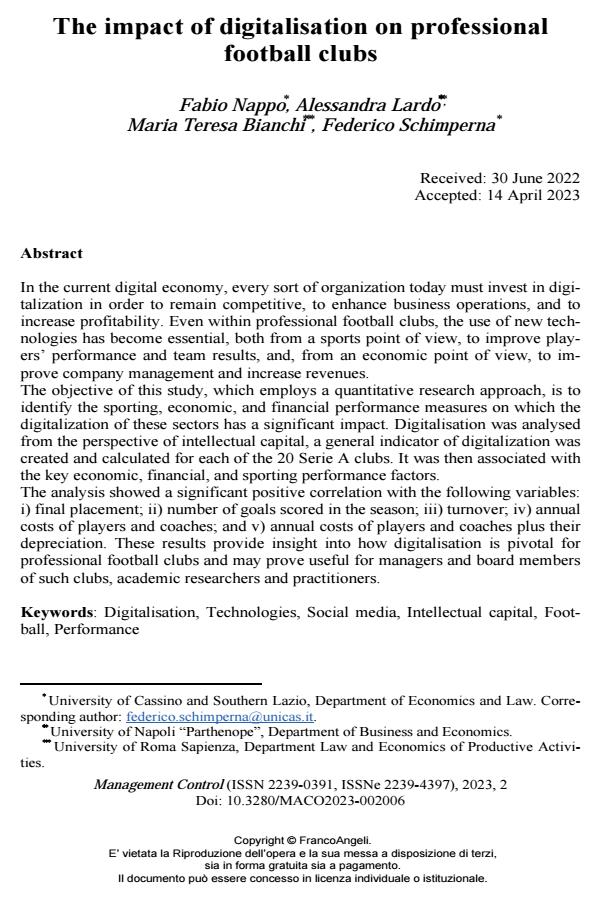The impact of digitalisation on professional football clubs
Journal title MANAGEMENT CONTROL
Author/s Fabio Nappo, Alessandra Lardo, Maria Teresa Bianchi, Federico Schimperna
Publishing Year 2023 Issue 2023/2
Language English Pages 20 P. 117-136 File size 231 KB
DOI 10.3280/MACO2023-002006
DOI is like a bar code for intellectual property: to have more infomation
click here
Below, you can see the article first page
If you want to buy this article in PDF format, you can do it, following the instructions to buy download credits

FrancoAngeli is member of Publishers International Linking Association, Inc (PILA), a not-for-profit association which run the CrossRef service enabling links to and from online scholarly content.
In the current digital economy, every sort of organization today must invest in dig-italization in order to remain competitive, to enhance business operations, and to increase profitability. Even within professional football clubs, the use of new tech-nologies has become essential, both from a sports point of view, to improve play-ers’ performance and team results, and, from an economic point of view, to im-prove company management and increase revenues. The objective of this study, which employs a quantitative research approach, is to identify the sporting, economic, and financial performance measures on which the digitalization of these sectors has a significant impact. Digitalisation was analysed from the perspective of intellectual capital, a general indicator of digitalization was created and calculated for each of the 20 Serie A clubs. It was then associated with the key economic, financial, and sporting performance factors. The analysis showed a significant positive correlation with the following variables: i) final placement; ii) number of goals scored in the season; iii) turnover; iv) annual costs of players and coaches; and v) annual costs of players and coaches plus their depreciation. These results provide insight into how digitalisation is pivotal for professional football clubs and may prove useful for managers and board mem-bers of such clubs, academic researchers and practitioners.
Keywords: Digitalisation, Technologies, Social media, Intellectual capital, Foot-ball, Performance
- Determinants of financial performance of Portuguese football clubs Ricardo Joaquim, Nuno Gonçalves, Liliana Pimentel, Bernardo Simões, in Sport, Business and Management: An International Journal /2025 pp.1
DOI: 10.1108/SBM-01-2025-0021 - DİJİTAL GELİR MODELLERİNİN FUTBOL KULÜPLERİNE EKONOMİK ETKİSİ İsmail Öner, Özgür Karataş, Emine Öztürk Karataş, in Mustafa Kemal Üniversitesi Eğitim Fakültesi Dergisi /2024 pp.137
DOI: 10.56677/mkuefder.1575323
Fabio Nappo, Alessandra Lardo, Maria Teresa Bianchi, Federico Schimperna, The impact of digitalisation on professional football clubs in "MANAGEMENT CONTROL" 2/2023, pp 117-136, DOI: 10.3280/MACO2023-002006